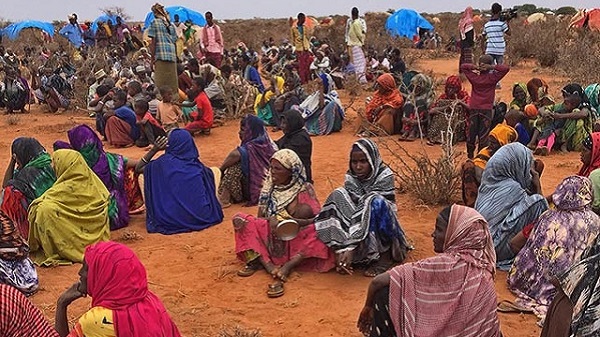
When they talk about saving livestock, it is about saving their livelihoods. The IDPs kept telling us to help with saving their core-breeding animals, says Mr Allahoury.
The drought situation on the ground shows urgency to intervene
Addis Ababa (FAO-Ethiopia)–Livestock is key to the livelihoods of millions of herders and semi-pastoralists in South and Southeastern areas that face a long dry spell with the failure of the October and December rains. Protecting the livestock-based livelihoods in the affected areas of Somali, Oromia and SNNP, in particular, has been taken as a major priority for FAO in 2017.
After visiting the affected communities in Somali Region, Mr Amadou Allahoury, FAO Representative in Ethiopia, said, “The scale of the drought impact is massive. Thousands of Internally Displaced People (IDP) are concentrated in temporary shelters, and livestock carcasses are everywhere and the remaining weak animals are highly concentrated around diminishing water ponds.”
Deteriorating situation
The drought has highly affected the most vulnerable population groups and cattle. Cattle are the first to die in a drought situation whereas camels and goats show better resistance to water and feed shortages. Most of the IDPs are women and children who need immediate support.
The scale of the drought impact is already high and the situation will definitely deteriorate in the coming months, added Mr Allahoury.
Strong link between livestock and livelihoods
Livestock rearing is a means of survival for the pastoral communities in the drought-affected areas.
In pastoralist vision, livestock and livelihoods are the same, said Mr Allahoury. “When they talk about saving livestock, it is about saving their livelihoods. The IDPs kept telling us to help with saving their core-breeding animals,” added Mr Allahoury.
Core-breeding animals will help with recovery and rebuild their livestock assets beyond the drought seasons.
Saving livestock-based livelihoods
Saving the livelihood-base of the affected community is FAO’s priority. It is essential to provide fodder and supplementary feeding for the core-breeding animals, remarked Mr Allahoury.
As water is also very scarce, rehabilitating and developing ground water facilities for animal use also contributes to saving the core-breeding animals, he added.
As a short-term intervention, FAO promotes animal destocking, which can help with using scarce resources for saving core-breeding animals in addition to providing nutritious food for vulnerable population and income for animal owners.
Building pastoral resilience
Mr Allahoury stated, in the long run, we have to create conditions to build the resilience of these populations through changing the current way of doing livestock rearing and promoting animal fodder production by making water available through catchments and developing ground water resources.
In 2017, FAO Ethiopia aims to support one million households in south and southeastern pastoral areas with livestock feed supplementation, animal health provision, animal destocking and cash-for-work schemes to rehabilitate water points.
Source: FAO
——
Other stories:
- Ethiopia Taking Steps to Address Drought Conditions
- Ethiopia: Surviving Hard Times through Therapeutic Foods
- USAID Provides School Supplies for Students in Drought Affected Areas
- World Bank Praises Ethiopia’s Economic Growth despite Worst Drought in Decades
- From Poverty to Profits: A Widow’s Story of Opportunities Seized and Futures Secured

Its enjoyable.keep it up.